
Nashia inaguensis is an evergreen shrub, commonly referred to as Moujean tea, Bahamas berry, or pineapple verbena. It is native to the east Caribbean islands, in particular the island of Inagua in the Bahamas, after which the species is named. In its native environment, the plant crawls along sunny, rocky outcroppings, semi-protected from steady high winds.

Pachypodium ambongense is a species of plant in the family Apocynaceae. It was first published as a species of the genus Pachypodium in 1924 by the botanist Henri Louis Poisson.

Calcitriol is the active form of vitamin D, normally made in the kidney. It is also known as 1,25-dihydroxycholecalciferol. It is a hormone which binds to and activates the vitamin D receptor in the nucleus of the cell, which then increases the expression of many genes. Calcitriol increases blood calcium (Ca2+) mainly by increasing the uptake of calcium from the intestines.
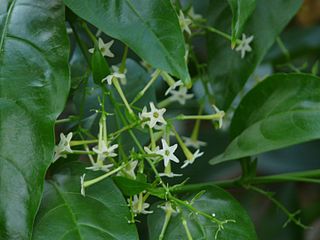
Cestrum nocturnum, the lady of the night, night-blooming jasmine, night-blooming jessamine, night-scented jessamine, night-scented cestrum or poisonberry, is a species of plant in the potato family Solanaceae. It is native to the West Indies, but naturalized in South Asia.
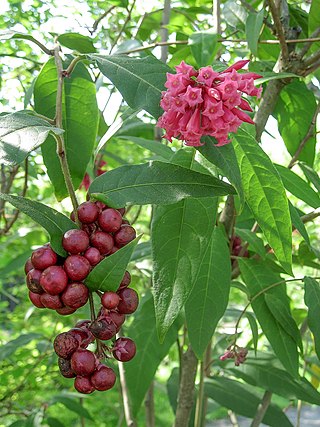
Cestrum is a genus of — depending on authority — 150-250 species of flowering plants in the family Solanaceae. They are native to warm temperate to tropical regions of the Americas, from the southernmost United States south to the Bío-Bío Region in central Chile. They are colloquially known as cestrums or jessamines.

Vasconcellea candicans is a small tree native to the western slopes of the Andes in southern Ecuador and Peru.

Cotyledon is one of some 35 genera of succulent plants in the family Crassulaceae. Mostly from Southern Africa, they also occur throughout the drier parts of Africa as far north as the Arabian Peninsula. Ten of its species are mostly confined to South Africa, where unlike Tylecodon, they occur commonly in both the winter and summer rainfall regions. They may be found on coastal flats and rocky hillsides, or as cremnophytes on cliff faces. Their decussate, evergreen leaves are very variable in shape, even within some species, but the flowers are, apart from colour, very similar.

Trachelospermum jasminoides is a species of flowering plant in the family Apocynaceae, native to eastern and southeastern Asia. Common names include Confederate jasmine, star jasmine, Confederate jessamine, and Chinese star jessamine.
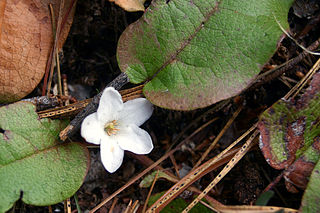
Epigaea repens, the mayflower, trailing arbutus, or ground laurel, is a low, spreading shrub in the family Ericaceae. It is found from Newfoundland to Florida, west to Kentucky and the Northwest Territories.
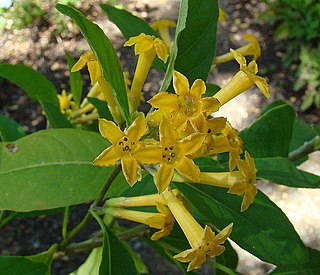
Cestrum parqui, commonly known as palqui, green cestrum, Chilean cestrum, green poisonberry, or willow-leaved jessamine, is a species of flowering plant native to Chile.
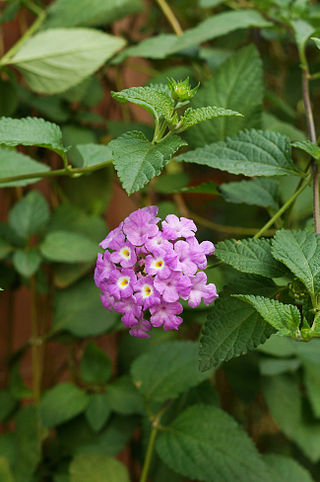
Lantana montevidensis is a species of lantana known by many common names, such as: trailing lantana, weeping lantana, creeping lantana, small lantana, purple lantana or trailing shrubverbena.
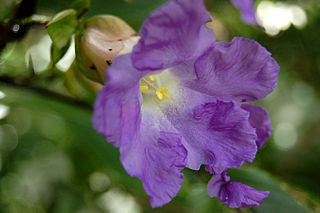
Strobilanthes callosa(Synonym: Carvia callosa Bremek) is a shrub found mainly in the low lying hills of the Western Ghats, all along the west coast of India. Its standardized Hindi name is maruadona (मरुआदोना) which it is called in the state of Madhya Pradesh where it is also found. In the state of Maharashtra, in the Marathi language, and other local dialects and in the neighboring state of Karnataka, the shrub is locally known as karvi (कारवी), sometimes spelled in English as karvy.
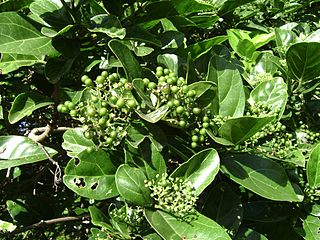
Premna serratifolia is a small tree/shrub in the family Lamiaceae. It flowers and fruits between May and November. During flowering season, it attracts a large number of butterflies and bees. Synonyms of Premna serratifolia Linn. include P. corymbosa Merr., P. integrifolia L. and P. obtusifolia R. Br.).

Rhododendron thomsonii (半圆叶杜鹃) is a rhododendron species native to northern India, Bhutan, Nepal, Sikkim, and southern Xizang in China, where it grows at altitudes of 3,000–4,000 m (9,800–13,100 ft). It is a shrub that grows to 2–4 m in height, with leathery leaves that are oblong-elliptic to ovate or orbicular to obovate, 3–7 by 2–6 cm in size. Flowers are red.

Globularia salicina is a shrub native to the archipelago of Madeira and to the central and western Canary Islands.
Trompettia cardenasiana is a species of nightshade that is a spiny shrub bearing very small leaves, 0.35–0.5 cm (0.1–0.2 in) by 0.1–0.12 cm (0.04–0.05 in), a yellow trumpet-shaped campanulate flower, measuring about 3 cm (1.2 in) long and globose fruit. The growth habit is somewhat reminiscent of certain Lycium species. It is endemic to Bolivia, growing in dry, Andean valleys at altitudes of 2,000–2,500 m (6,600–8,200 ft) and 3,000–3,500 m (9,800–11,500 ft) and has been collected near the town of Cotagaita in Potosí Department.
Rauvolfia micrantha, the small-flowered snakeroot, is a plant that is indigenous to southwestern India, southern Thailand, and Vietnam. It has a woody, shrub-like appearance and attractive flowers.

Allophylus decipiens (E.Mey.) Radlk., commonly known as the bastard taaibos, is a multi- or single-stemmed, small, evergreen tree about 3–4 m in height occurring in coastal forest, fringe forest and thickets, and wooded ravines and streams. Found up to 800 m in the southern coastal regions of the Cape Province, KwaZulu-Natal, Eswatini, along the escarpment forest of Mpumalanga, including Soutpansberg and in Mozambique. There are some 219 species in the genus of Allophylus.

Myrsine kermadecensis, commonly known as the Kermadec matipo, Kermadec myrsine, or the Kermadec mapou, is a species of flowering plant in the family Primulaceae, edemic to the Kermadec Islands of New Zealand. It was named by Thomas Cheeseman in 1888, and first described in 1892.

Gaultheria adenothrix, known as アカモノ (akamono) or イワハゼ (iwahaze), is a small evergreen shrub in the Ericaceae. It is one of three Gaultheria species native to Japan and grows in low-mountain to subalpine areas.


















